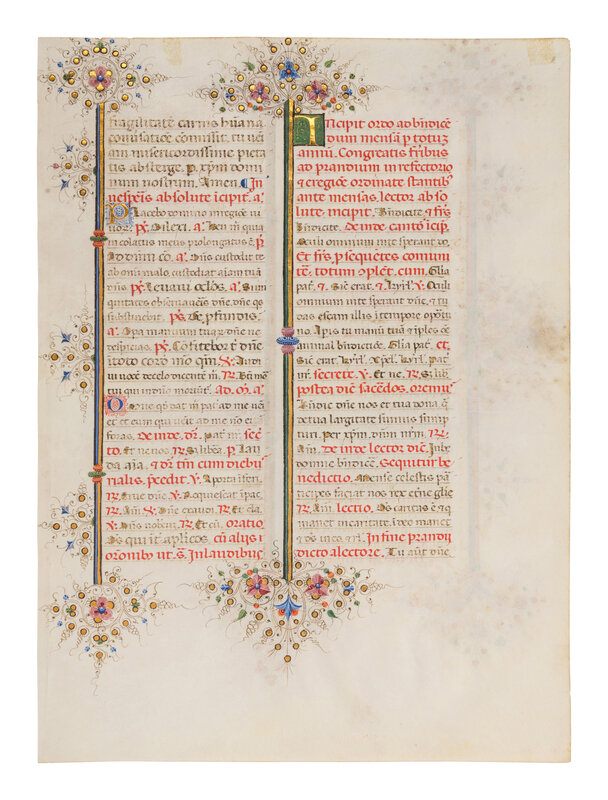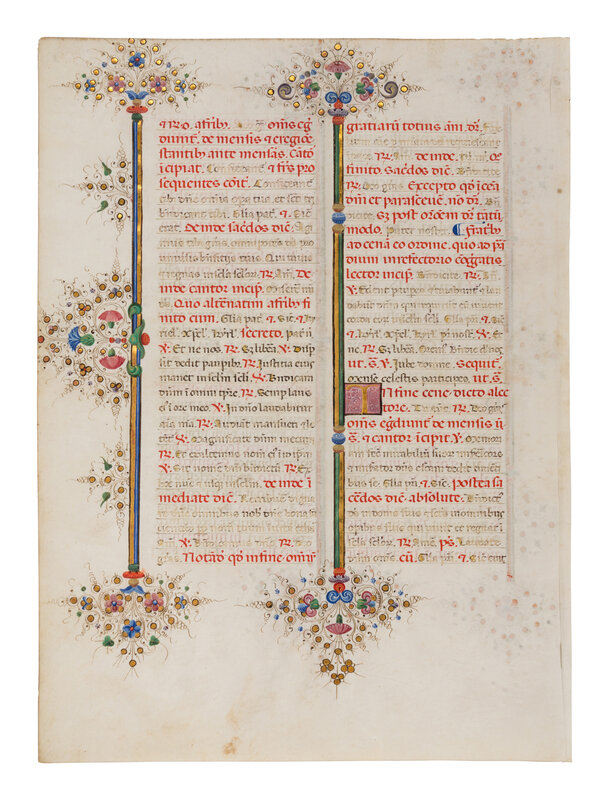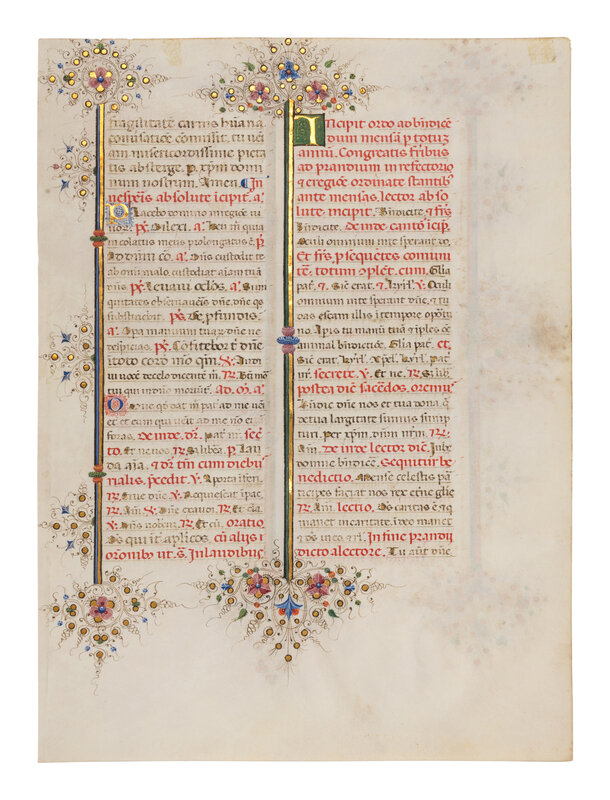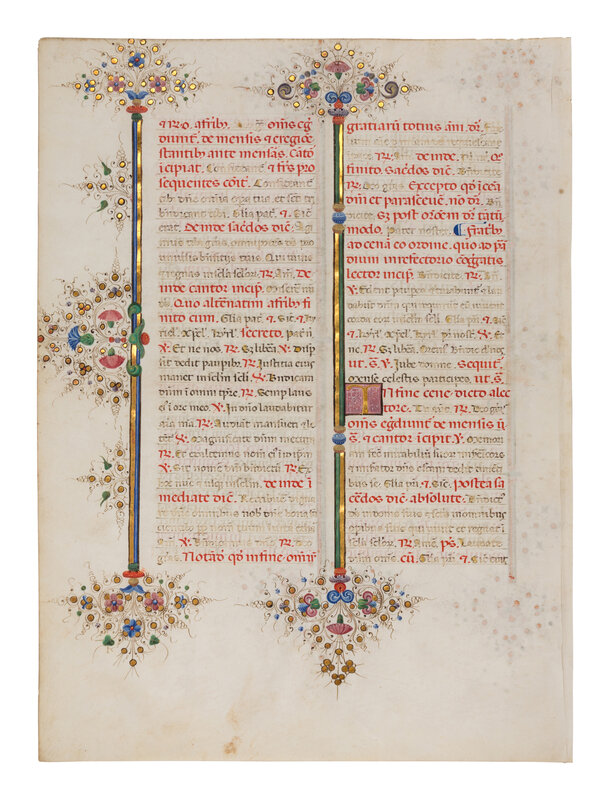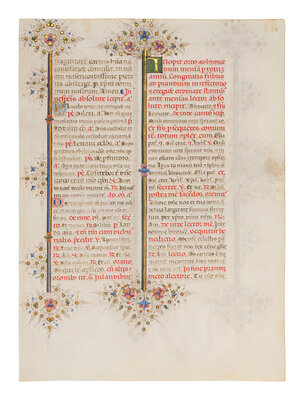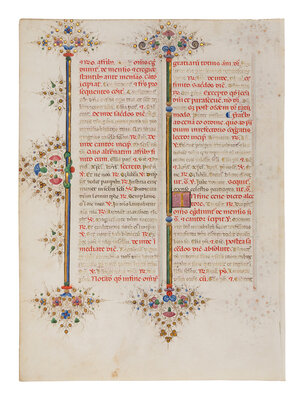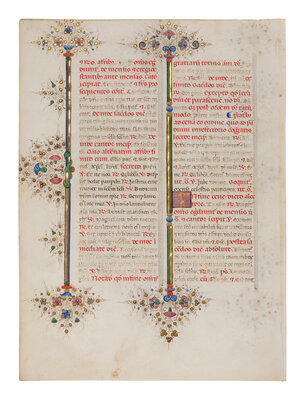Condition Report
Contact Information
Lot 52
GIORGIO D’ALEMAGNA (documented Ferrara, 1441-1462)
A leaf from the Breviary of Lionello d’Este, also known as the Llangattock Breviary, in Latin, illuminated manuscript on parchment [Italy, Ferrara, c. 1441-1448]
A leaf from the Breviary of Lionello d’Este, also known as the Llangattock Breviary, in Latin, illuminated manuscript on parchment [Italy, Ferrara, c. 1441-1448]
Sale 2033 - Western Manuscripts and Miniatures
Jun 27, 2024
10:00AM CT
Live / Chicago
Own a similar item?
Estimate
$2,000 -
3,000
Lot Description
GIORGIO D’ALEMAGNA (documented Ferrara, 1441-1462)
A leaf from the Breviary of Lionello d’Este, also known as the Llangattock Breviary, in Latin, illuminated manuscript on parchment [Italy, Ferrara, c. 1441-1448]
A leaf from the Breviary of Lionello d’Este, also known as the Llangattock Breviary, in Latin, illuminated manuscript on parchment [Italy, Ferrara, c. 1441-1448]
Unrecorded text leaf from a masterpiece of Renaissance illumination, the Llangattock Breviary.
272 x 200 mm. Single leaf, ruled in lead for two columns of 30 lines (written space: 167 x 130 mm), written over top line in a rounded late gothic bookhand in black ink, the text from the end of the Divine Office, from the Vespers of the Office of the Dead to the Ordo for the Blessing of the Altar, rubrics in red, one-line initials in blue or liquid gold with contrasting red or dark blue penwork, two-line initials in burnished gold on a green ground with white tracery (recto) and mauve ground with white tracery (verso), full-length bar-borders of colored flowers and burnished gold discs on scrolling vine stems or of burnished gold and colored bars, flowering in the margins and at top and bottom into sprays (faded ink in some sections of text, else in good condition, fore-edge trimmed up to outer illuminated sprays).
This leaf contains the end of the Divine office, from the Vespers of the Office of the Dead to the Ordo for the Blessing of the Altar and comes from a masterpiece of Ferrarese illumination: the Llangattock Breviary. The latter originally comprised more than five hundred leaves and was created as a luxurious liturgical manuscript for Lionello d’Este (1407-1450), Marchese of Ferrara. Lionello was a wealthy patron of the arts, tied to such artists as Guarino da Verona, Leon Battista Alberti, Giovanni Bellini, Andrea Mantegna, and Pisanello. Archival records demonstrate that it was commissioned by Lionello from the artist Giorgio d’Alemagna and his assistants. Begun in 1441 and finished in 1448, the manuscript was copied by the scribe Francesco de Codigoro, with Giorgio d’Alemagna as its principal illuminator. In 1443, the enormity of the project resulted in the enlistment of Guglielmo Giraldi, Jacopo Magnanina, Matteo de’ Pasti and Bartolomeo Benincà as assistants to the illumination.
The Llangattock Breviary demonstrates strong similarities with another work attributed to Giorgio d’Alemagna, the Missal of Borso d’Este (Modena, Bibliotheca Estense Universitaria, ms. a.W.5.2 = Lat. 239), illuminated between 1449 and 1457 for Lionello’s brother. The size, format, and illumination of the manuscript correspond to those of the Missal, suggesting that both manuscripts were most likely made for his predecessor Lionello and intended for use in the ruler’s private chapel. Giorgio d’Alemagna also contributed to the monumental Bible of Borso d’Este (Modena, Bibliotheca Estense Universitaria, ms. Lat 422 and Lat 423).
Provenance
Private collection, California, MS 226.
Parent manuscript
The Llangattock Breviary was named after its nineteenth-century owner, John Etherington Wells Rolls (1807-1870), first Baron Llangattock, whose bookplate it included, alongside inscriptions recording its acquisition after the Peninsular War in the early nineteenth century. The manuscript was sold as part of the library of his son John Allan Rolls (1870-1912), 2nd Baron Llangattock, at Christie’s, 8 December 1958, lot 190. It was then acquired by the Goodspeed Book Shop of Boston, who dismantled it and began to sell the leaves separately.
Sister leaves
The leaves of the Llangattock Breviary are now dispersed in public and private collections around the world. A virtual reunification has been proposed on the “Broken Books” website (brokenbooks.omeka.net), which records 115 leaves as of April 2024. The site is maintained by Debra Cashion, whose findings were first published in 2021. Some leaves are illuminated with historiated miniatures, in Paris (Musée du Louvre, Arts graphiques, RF 51871) and Cambridge, Mass. (Harvard University, Houghton Library, MS Typ 301). Further leaves are to be found, for instance, at U.C. Berkeley, the American Academy in Rome, Michigan State University, University of South Carolina, Dartmouth College, to cite but a few.
Two sister leaves of the Llangattock Breviary are nos. 26 and 36a of the present sale.
LITERATURE
On the parent manuscript, see Federica Toniolo, in Les Enluminures du Louvre, Moyen Âge et Renaissance, ed. François Avril, Nicole Reynaud, and Dominique Cordellier, Paris, 2011, no. 45; and Debra Cashion in The Burke Collection of Italian Manuscripts Paintings, ed. Sandra Hindman and Federica Toniolo, London, 2021, no. 32, pp. 322-331.
Freeman’s | Hindman thank Senior Consultant Sandra Hindman and Elliott Adam for their assistance in preparing this sale.
Property of a Private California Collector
